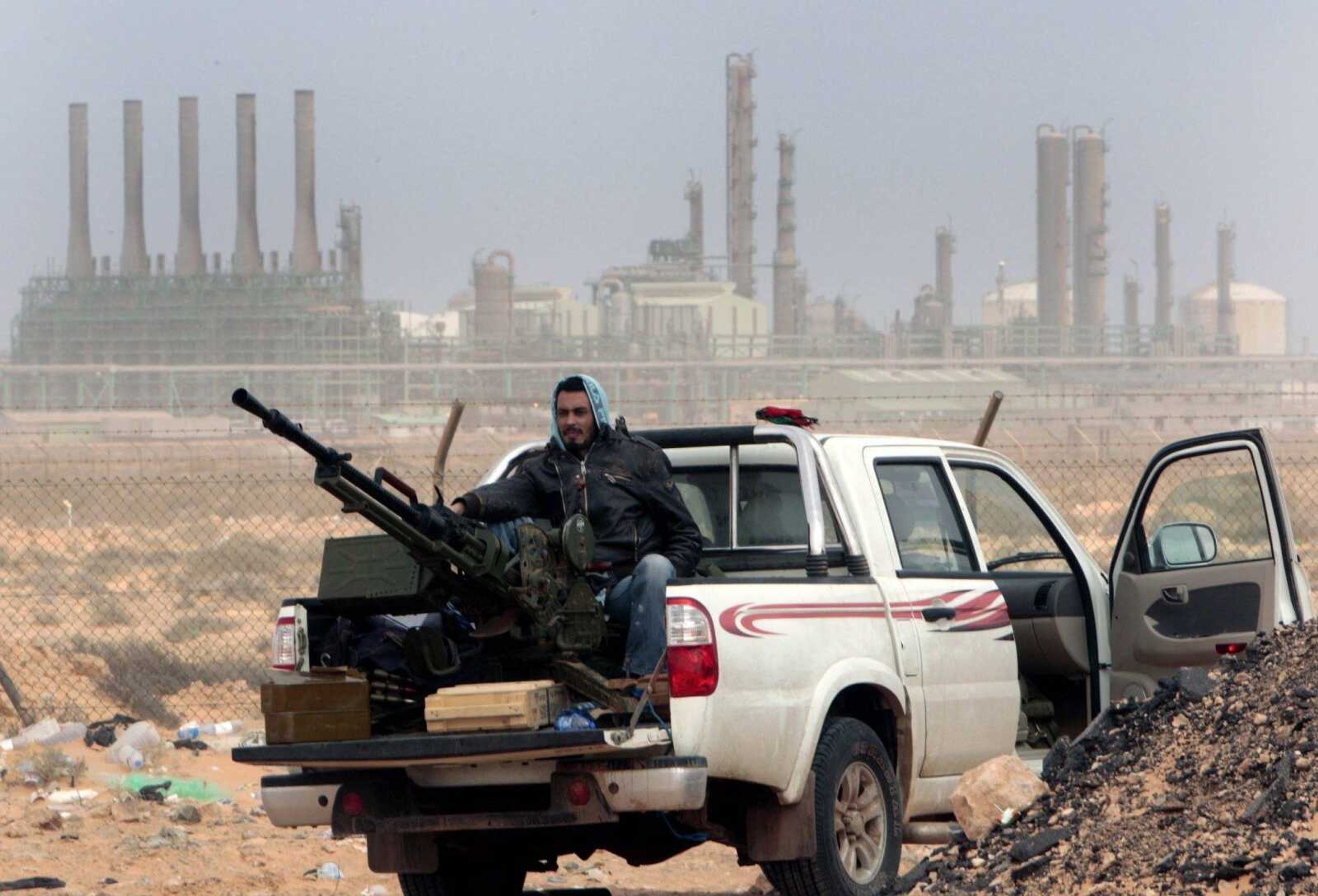Libya's deepening split finds battleground at oil terminals
CAIRO -- Hundreds or thousands of armed men are converging on Libya's main oil-shipping terminals, which the rival powers in the country's east and west are fighting to control in a battle being watched by global oil markets. The struggle for the Ras Lanuf refinery and nearby Sidr depot threatens to spiral into an all-out conflict between east and west...
CAIRO -- Hundreds or thousands of armed men are converging on Libya's main oil-shipping terminals, which the rival powers in the country's east and west are fighting to control in a battle being watched by global oil markets.
The struggle for the Ras Lanuf refinery and nearby Sidr depot threatens to spiral into an all-out conflict between east and west.
Already, it has seen the bloodiest fighting yet between the two camps: About 40 troops from the east were killed over four days as militias backed by western factions stormed the area Friday, losing a handful of casualties.
Now forces from the east loyal to military strongman Khalifa Hifter are massing nearby, threatening a new assault to wrest back the facilities, which nominally are in the hands of the Tripoli government.
In another step, the eastern parliament Tuesday voted to withdraw support from the United Nations peace deal that created the Tripoli government in January 2016 in hopes of ending years of chaos in the North African country. The withdrawal of support undermines the government, which has had difficulty asserting authority even in Tripoli.
Hifter, an army general, former CIA asset and U.S. citizen who lived nearly 20 years in American exile, is the most powerful figure in the east, touting himself as the champion against Islamic militants in Libya -- though his enemies accuse him of aiming to become a new dictator like Moammar Gadhafi, who was overthrown and killed in the country's 2011 Arab Spring revolt.
He has talked of marching to take Tripoli to unite the country, hinting he aims to rule. He opposed the government set up by the U.N. peace deal because it would have pushed him out as head of the military.
The general is backed by Egypt and Russia, but Washington under the Obama administration kept him at arm's length. One question in his future will be whether the U.S. warms up to him under President Donald Trump, who has sounded more favorable to Egypt and more open to dealing with regional strongmen.
Hifter commands a collection of militias and eastern tribal forces as well as the remnants of the Libyan National Army, including Gadhafi-era officers.
Hifter also is allied to the eastern-based parliament, which was the last legislature to be elected in Libya and had to flee east when opponents took over the west in 2014.
Hifter's forces seized the oil facilities last year. The Obama administration had joined the U.N. in calling on him to hand them over to the Tripoli government. Hifter had seemed more inclined to use them as a bargaining chip to force a rewriting of the peace accord.
But now that they have been wrested from him by force, he may resort instead to an all-out fight against Tripoli. His army says it is massing forces east of the terminals, awaiting orders. Their strength is unclear but they can call on reserves of thousands of eastern Libyan fighters and tribesman and are backed by Libyan and foreign air support. Hifter travels regularly to Cairo and insiders have said he flew there shortly after losing control of the terminals.
The Tripoli government was created under the U.N. deal in hopes of ending the east-west split. Instead, it has become just another player in that divide, reliant on its militia allies to have any authority.
Chief among those allies are the militias of the neighboring city of Misrata, the strongest and most cohesive fighting force in the west. The Misrata militias provide security for the Tripoli government and it was they who earlier this year captured the Islamic State group's main stronghold, Sirte, effectively defeating for now the extremists' attempt to extend their caliphate to Libya.
The international community has tried to bolster the Tripoli government -- particularly Italy, which is heavily invested in Libya's oil sector and has a military presence in the capital in the form of an army hospital that treated Misrata fighters during the battle against IS.
It was a newly formed militia that retook the oil facilities at Ras Lanouf and Sidr. The Benghazi Defense Brigades, as it is called, depicts itself as an eastern-based force, made up of former rebels and Islamic militants recently defeated by Hifter's forces in the eastern city of Benghazi. But it is clearly linked to the west, with some Misrata fighters in its ranks -- and its commanders recently held a press conference in Misrata.
The Brigades handed the oil facilities over to the control of the Tripoli government, which has ordered its National Petroleum Guards under Brig. Gen. Idris Abukhamada -- the official guard force for oil infrastructure -- to deploy at the sites.
Oil prices have dropped over the past week because of growing U.S. supplies, frustrating OPEC attempts to bolster the price by curbing production. While the supply glut is the biggest factor dominating the market, the Libya fighting has potential to put some upward pressure on prices.
It did so when the Brigades took Ras Lanouf and Sidr last week, forcing the shutdown of the maritime export terminals there, Libya's largest. That spooked the markets, causing a brief blip of higher prices. The facilities remain closed, causing some reduction in Libya's production, which in February had reached 700,000 barrels a day.
Oil is Libya's only real source of revenue, and it has been trying to rebuild the industry, though it remains but a shadow of the 1.6 billion barrels a day produced in 2011. While the oil facilities have changed hands several times over the past years, the revenues have continued to flow into the central bank based in Tripoli, an arrangement accepted by all parties that for the moment is not in doubt.
Heavier fighting at the facilities could further scare traders, especially if infrastructure is damaged.
The ball appears to be in Hifter's court. His forces could face only weak opposition if they stormed Ras Lanouf and Sidr, protected only by the official oil guard units.
But the impact could be much wider.
Until now, the powers in east and west have largely avoided fighting directly, instead battling through proxies. Storming the oil facilities would be a direct assault by Hifter on the internationally backed Tripoli government since it officially holds them now. Hifter would likely be seen as flouting the United Nations and European countries, which have called for a cease-fire.
That opens the door to further possible escalations. How far Hifter goes depends on whether he finds international supporters, but he could try to carry out his threats to move against Tripoli, pitting him against Misrata's powerful fighters.
Connect with the Southeast Missourian Newsroom:
For corrections to this story or other insights for the editor, click here. To submit a letter to the editor, click here. To learn about the Southeast Missourian’s AI Policy, click here.






